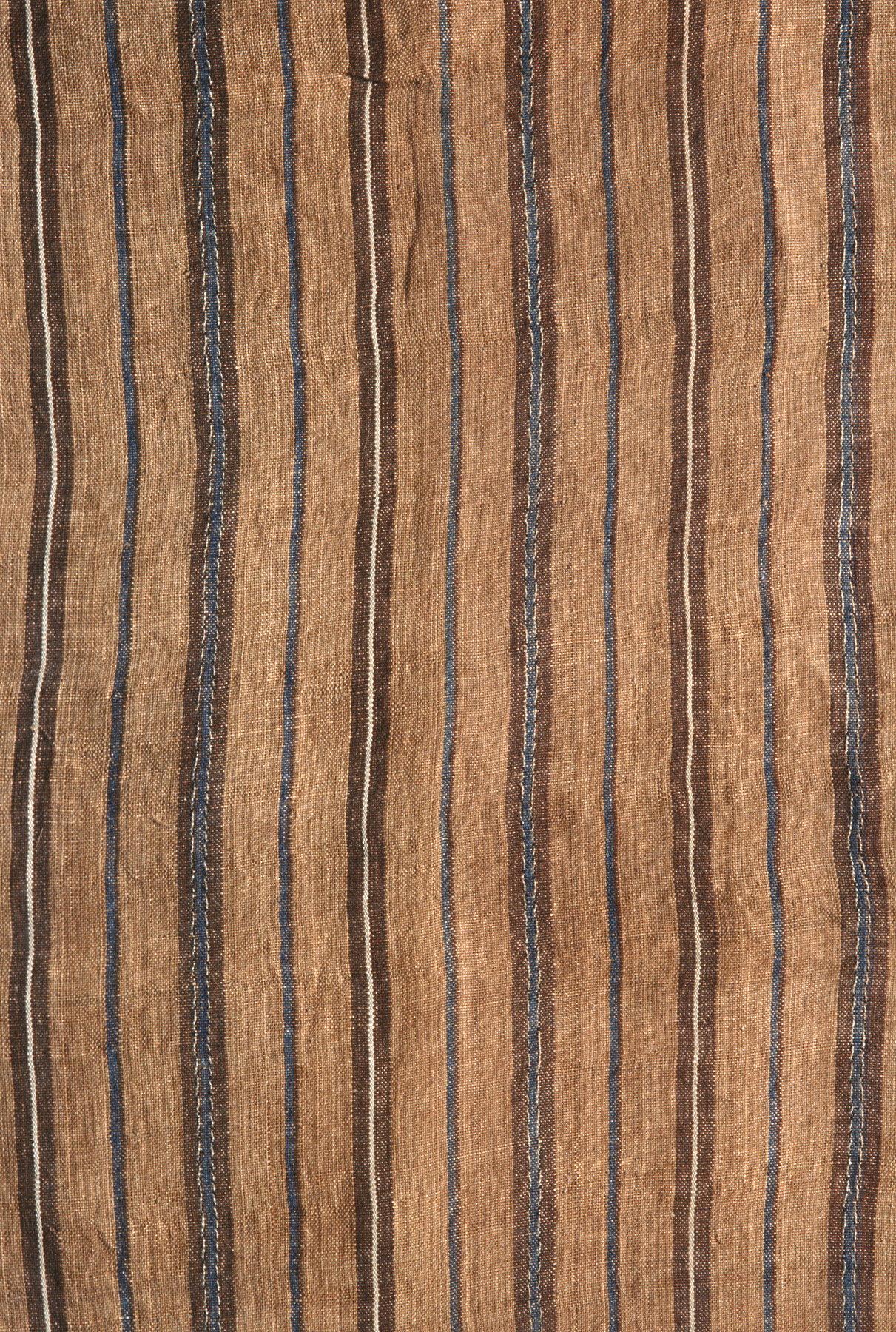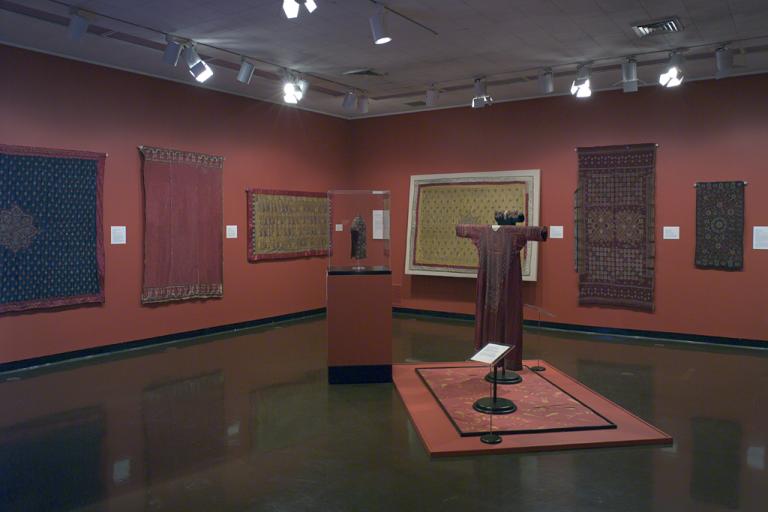Exhibition Label:
“Flowers, Dragons and Pine Trees: Asian Textiles in the Spencer Museum of Art,” Nov-2005, Mary Dusenbury
This traditional Okinawan garment is woven of thread made from the thread-banana (Musa liukiuensis). It is cut to reach halfway between knee and ankle, with a very long neckband and tubular sleeves sewn completely to the body of the garment.
Exhibition Label:
Asian Gallery, Spring 2003
(Didactic panel is from Mary M. Dusenbury’s forthcoming book ‘Flowers, Dragons, and Pine Trees: Textiles from the Spencer Museum of Art.’ (Anticipated publication date: late 2003))
Okinawa Textiles
Located at the confluence of several major ocean currents midway between Tokyo and Southeast Asia, Okinawa is composed of 160 islands extending over a vast area of ocean. Trade with the Asian mainland flourished after the islands were unified under the Ryukyu king in 1429. After the Satsuma from Kyushu invaded Ryukyu in l609, Satsuma and the Bakufu used the archipelago to conduct trade with China.
The weaving and dyeing arts developed in the Ryukyu islands benefited from and were important components of this trade. Bingata dyeing, for instance, is believed by some to have been influenced by techniques practiced in Fujian in southern China. These techniques took on unique characteristics in the Ryukyus, where textiles are often said to closely reflect the beauty of nature in the islands. Bingata is characterized by a clear, brilliant palette with hues that many visitors have likened to the colors of the sea, sky, forests, dazzling coral reefs, and bright flowers of the islands. Bashofu is made with threads spun from the fibers of the ito basho plant, which belongs to the banana family. Thin, cool and durable, it is valued for its comfortable feel in the humid summer weather and was formerly woven for common, everyday use throughout the Ryukyu. To produce just one tan (bolt) of bashofu requires approximately forty ito basho plants, which take three years to mature. Manufacture of a bolt of jofu, the highest grade of cloth, requires fourteen stages of processing.
By the late l6th century, the Ryukyuan court was sending high quality bashofu to the Ming court in China as tribute. In l610, following the Satsuma invasion of Ryukyu, bolts of bashofu were included in the submission gifts that King Sho Nei presented to retired shogun Tokugawa Ieyasu and to his son, the ruling shogun Tokugawa Hidetada. By l638 the domain of Satsuma was selling bashofu in Kyoto as one of its own "famous products."
In l879 the Ryukyu Kingdom was abolished and became Okinawa Prefecture. Amazed at the high level of skills and the variety of traditional crafts when he first visited in l938, Sosetsu Yanagi, founding father of the Japan folk craft movement, declared that Okinawa was a virtual treasure trove of folk crafts. Today Okinawa is referred to in Japan as the "Treasure House of Weaving and Dyeing," and bashofu, bingata, and other Okinawan textiles are prized items in the collections of world-class museums and art galleries.
Exhibition Label:
Asian Gallery, Spring 2003, Youmi Efurd
This garment is constructed with the long neckband and tubular sleeves that are characteristic of Okinawan costume. It is cut to reach half-way between the knee and ankle. The natural light brown of the banana fiber is set off by cotton warp-way stripes in brown, light blue, and natural white. Tiny vertical lines, made by plying a white and a colored cotton thread together (moku ito), add a subtle visual interest. The construction of the garment, use of the inner bark of the indigenous (or possibly indigenized) thread banana (musa basjoo), the moku ito technique, and the lively simplicity of the patterning are all typical of Okinawan textiles.
Archive Label 2003 (version 2):
In 1993, a private collection of carefully chosen Japanese textiles came onto the market. The Spencer Museum purchased a number of these textiles to broaden the museum’s collection and include textiles representative of styles produced or worn outside of the cosmopolitan centers of Kyoto, Osaka, and Edo (Tokyo).
This kimono would have been worn by a member of the shônin (commoner) class. The garment is constructed with the long neckband and tubular sleeves that are characteristic of Okinawan costume. It is cut to reach halfway between knee and ankle. The natural light brown of the banana fiber is set off by cotton warp-way stripes in brown, light blue and natural white. Tiny vertical lines, made by plying a white and colored cotton thread together (moku ito), add subtle visual interest. The construction of the garment, the use of the inner bark of the indigenous “thread banana” (musa basjoo), the moku ito technique, and the lively simplicity of the patterning are typical of Okinawan textiles.



